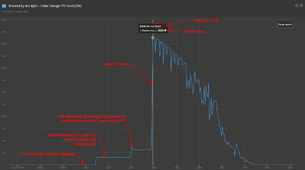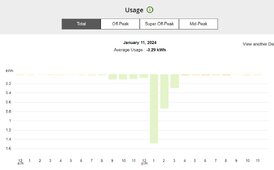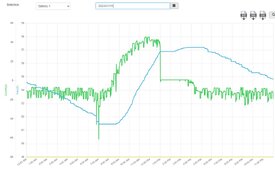I am still grid tied but setup for backup off grid.
The Schneider XW-Pro input is connected to the grid with the 20 amp breaker in the main panel where my Enphase solar used to go. The output of the XW-Pro now feeds a sub panel. The Enphase solar is now in the sub panel along with my backup loads circuits. The usual basics are in the backup panel. The fridge, furnace, some lighting, the computers, and a few other important things.
While the grid is up, the Enphase system essentially works in parallel to the XW-Pro. I have a 3rd party PLC controller that monitors the energy production and usage and sends commands to the XW-Pro to zero the grid power. If the Enphase is making more power than I am using, it puts the XW into charge mode and adjusts the charge current to zero the grid. When the sun goes down, or any time solar is not meeting the energy usage, the PLC commands the XW to export enough power to again zero the grid current. Without the PLC, the XW can't charge on it's own from the AC coupled Enphase inverters. It is a shame the XW is such a solid piece of hardware, held back by lacking firmware. But the Modbus controls are very good, if you can program it. And yes, it even pushes current back to the main panel to cover the non backup loads as well. On good solar days, when the battery becomes full, The XW has to stop charging the battery. At that time, the extra power from the Enphase system still flows back through the XW and out to the grid and I get credit for that export just as I did before the XW was installed. Yesterday, I used zero grid power and exported a bit over 3 KWHs to the grid.
If (when) the grid does go down, then the XW-Pro does form the grid and power the backup loads panel. This does not happen very often here, and never for very long. I should do another test as Enphase has updated my firmware again. Last time, a few of my iQ7's refused to stay running and reported "grid instability". The XW also has a firmware update to improve stability, but I have not loaded it yet. Running my backup loads for 2 hours, my battery bank only lost about 5% SoC so I was doing fine. The worst issue with my setup would be if we were off grid long enough for the battery bank to run down to shut down. The system could not self start again.
To get around the off grid charging issue and the dark start problem, I added the 2,000 watts of panels with a DC charge controller. That will always just push power to the batteries when the sun shines. So even if the Enphase inverters are not happy, I will still have some power coming in, and it can charge the battery enough to make the XW power back up, even if no one is here.
On days with good sun, the Enphase panels power the house while the sun is up, and the DC panels charge the battery for power at night. And that would work even without my PLC controller now. But the PLC also forces the XW to charge when the Enphase system makes more than I need during the day. Storing the power rather than exporting it for half credit. If I was designing the system from scratch, I would go more DC coupled as it is more efficient for night time power. I lose about 1 KWH per day in extra loses with the DC to AC then AC back to DC, and finally, DC back to AC yet again. The DC panels directly charge the batteries, and the the XW just does one DC to AC conversion when I need the power.







